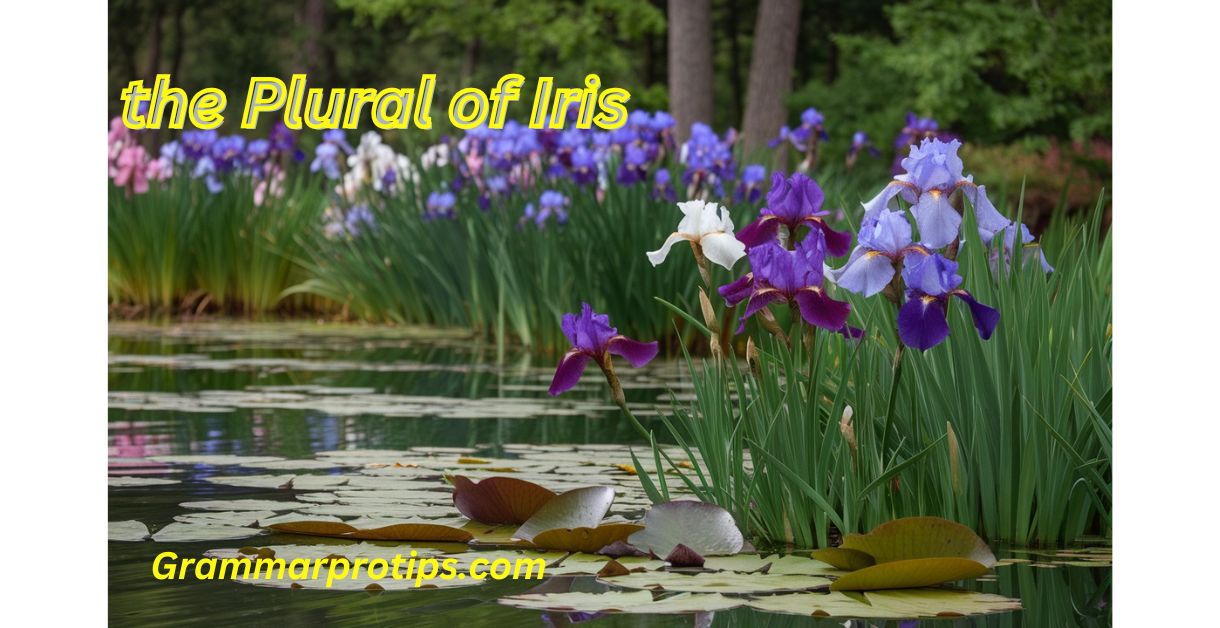The question “What’s the plural of iris?” might seem straightforward, but as is often the case in English, the answer isn’t always as simple as it seems. The word “iris” can refer to both the flower and the eye, each with its own plural form and specific usage.
To clear up any confusion, let’s explore the plural of iris flowers and the plural of iris eye in detail. We’ll also dive into scenarios and provide examples to make the explanations more relatable and easy to understand.
Understanding the Word Iris
Before we jump into the plural forms, it’s essential to understand what iris refers to. The term “iris” has two primary meanings:
- Iris (flower): A beautiful, colorful flower that grows in many varieties. It comes in colors like purple, blue, yellow, and white.
- Iris (eye anatomy): The colored part of the eye, which controls the size of the pupil and regulates the amount of light that enters the eye.
Both meanings are commonly used in everyday language, but they each have a different plural form. Let’s break this down step by step.
What Is the Plural of Iris Flower?
The plural of the iris flower is irises. This is the most straightforward pluralization, following the typical pattern for words ending in -is. For example:
- One iris in the garden, but two irises.
- Irises bloom in various colors throughout the spring.
Scenario Example: A Flower Garden
Let’s say you’re emailing a friend about a recent gardening project.
Subject: Spring Blooms in My Garden!
Hi Sarah,
I just wanted to share how my garden is looking this spring! The irises I planted last year have really taken off. There are so many irises in purple and white—it looks beautiful. Have you planted any irises in your garden this year?
Best,
Emily
In this scenario, the use of irises refers to multiple flowers, following the correct plural form for the iris flower.
What Is the Plural of Iris Eye?
When referring to the iris as part of the eye, the plural is irides. This word, irides, comes from the Latin plural form. The term irides is commonly used in anatomy and medical contexts. For example:
- One iris controls the pupil, but irides in both eyes work together to regulate light entry.
Scenario Example: Eye Anatomy
Imagine you’re receiving an email from a colleague about eye health.
Subject: Eye Health Update
Dear John,
I wanted to share an interesting article I read about irides. It discussed how the irides in both eyes control the size of the pupil, adjusting for different light conditions. The iris in each eye plays such a crucial role in vision, it’s fascinating to learn more about its functions!
Best regards,
Rachel
In this case, the use of irides refers to the plural of iris when talking about the eye’s anatomy.
Plural of Iris: Why the Difference?

The difference between the plural forms irises (for the flower) and irides (for the eye) is rooted in how the words evolved in the English language. The word iris comes from Greek mythology, where Iris was the goddess of the rainbow. In the case of the iris flower, the word was borrowed into English in the 16th century, and its pluralization follows the regular pattern for words ending in -is (like crisis becoming crises).
On the other hand, iris in the context of eye anatomy comes from Latin, where the plural form of certain words ending in -is is typically -ides (such as genus becoming genera). So, irides follows this Latin convention.
Additional Uses of the Word Iris
Iris Flower Varieties
There are many varieties of iris flowers that come in various colors and shapes. Some of the most common varieties include:
- Bearded Iris: Known for their distinct, fuzzy beards on the petals.
- Siberian Iris: Known for their elegant, delicate flowers.
- Dutch Iris: Often grown as cut flowers, these are popular in floral arrangements.
If you’re planning to expand your flower garden, planting different types of irises is a great choice. Not only are they visually stunning, but they also thrive in a variety of climates.
Iris Meaning
The iris has various meanings depending on its context. In addition to its botanical and anatomical uses, the word iris can also refer to:
- Iris as a name: A popular female given name derived from the flower.
- Iris in mythology: In Greek mythology, Iris was the messenger of the gods, often depicted with a rainbow trail.
Pronunciation and Common Mistakes
When it comes to pronunciation, irises (plural of iris flower) and irides (plural of iris eye) may sound similar, but they are distinct. The pronunciation for irises is /ˈaɪrɪsɪz/, while irides is pronounced /ˈɪrɪdiːz/.
It’s easy to mix up the two, especially in casual conversation. However, it’s important to use the correct plural form depending on whether you’re talking about flowers or eye anatomy.
Table: Plural Forms of Iris
To make things clearer, here’s a quick reference table showing the correct plural forms:
| Context | Singular | Plural |
|---|---|---|
| Iris (flower) | Iris | Irises |
| Iris (eye anatomy) | Iris | Irides |
| Iris (botanical varieties) | Iris | Irises |
Other Related Terms
- Iridescent: Something that shows a play of colors, similar to the appearance of the iris (both flower and eye).
- Irides: Plural of iris in the context of eye anatomy. This term is less commonly used in casual language but more prevalent in medical and anatomical contexts.
- Iris Flower Plural: As discussed, the correct plural form is irises when referring to the flowers.
- Eye Color: The iris is responsible for the color of your eyes. The irises of two people can differ in color, such as brown, blue, or green.
Genetic Traits and Eye Color
The color of the iris in human eyes is determined by genetic traits. Some individuals have irises with more melanin, which results in brown eyes, while others have less melanin, leading to blue or green eyes. Interestingly, the genetics of eye color is more complex than just a single gene, involving multiple genetic factors.
Frequently Asked Questions
What’s the Plural Form of Iris?
- Iris (flower): The plural form is irises.
- Iris (eye): The plural form is irides.
How Do You Pronounce Irises and Irides?
- Irises: /ˈaɪrɪsɪz/
- Irides: /ˈɪrɪdiːz/
What is the Definition of Iris Eye?
The iris of the eye is the colored ring around the pupil that controls how much light enters the eye by adjusting the size of the pupil.
What’s the Plural of Iris Flower Crossword Clue?
The answer to this common crossword clue would be irises, which is the plural form of the iris flower.
In conclusion, understanding the plural form of iris can be a bit tricky because of the two main contexts in which the word is used. However, with a little attention to detail, you’ll easily know when to use irises for the flower and irides for the eye. The next time someone asks you, “What’s the plural of iris?” you’ll be able to confidently provide the correct answer, backed by real-life examples and scenarios. Happy learning!

“Smith is the dedicated admin of [grammarprotips.com], a platform focused on enhancing grammar skills. With a passion for language and education, Smith strives to make grammar accessible and enjoyable for learners of all levels. Committed to delivering high-quality content, Smith continually explores innovative ways to help users master the complexities of grammar.”

